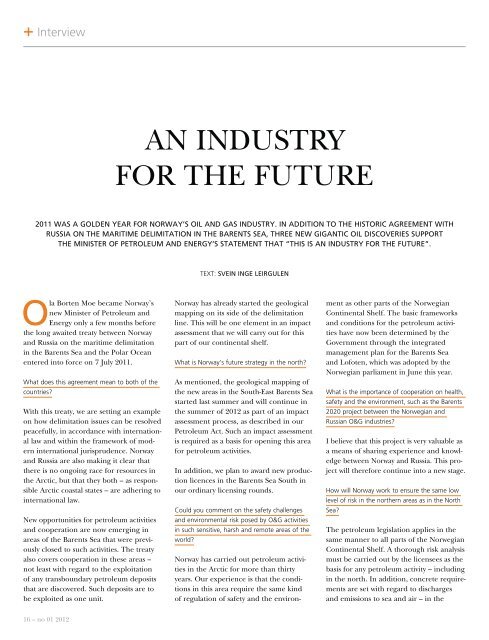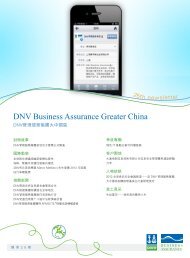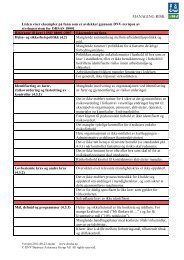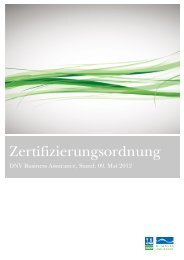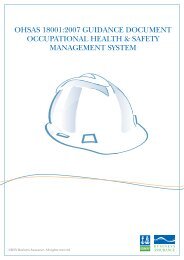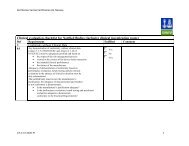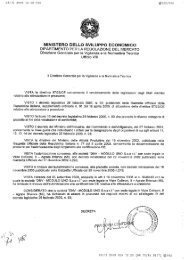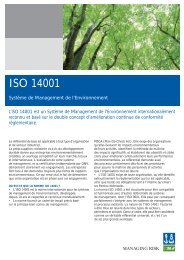Download - DNV Business Assurance
Download - DNV Business Assurance
Download - DNV Business Assurance
Create successful ePaper yourself
Turn your PDF publications into a flip-book with our unique Google optimized e-Paper software.
+ Interview<br />
AN INDUSTRY<br />
FOR THE FUTURE<br />
2011 WAS A GOLDEN YEAR FOR NORWAY’S OIL AND GAS INDUSTRY. IN ADDITION TO THE HISTORIC AGREEMENT WITH<br />
RUSSIA ON THE MARITIME DELIMITATION IN THE BARENTS SEA, THREE NEW GIGANTIC OIL DISCOVERIES SUPPORT<br />
THE MINISTER OF PETROLEUM AND ENERGY’S STATEMENT THAT “THIS IS AN INDUSTRY FOR THE FUTURE”.<br />
TEXT: SVEIN INGE LEIRGULEN<br />
Ola Borten Moe became Norway’s<br />
new Minister of Petroleum and<br />
Energy only a few months before<br />
the long awaited treaty between Norway<br />
and Russia on the maritime delimitation<br />
in the Barents Sea and the Polar Ocean<br />
entered into force on 7 July 2011.<br />
What does this agreement mean to both of the<br />
countries?<br />
With this treaty, we are setting an example<br />
on how delimitation issues can be resolved<br />
peacefully, in accordance with international<br />
law and within the framework of modern<br />
international jurisprudence. Norway<br />
and Russia are also making it clear that<br />
there is no ongoing race for resources in<br />
the Arctic, but that they both – as responsible<br />
Arctic coastal states – are adhering to<br />
international law.<br />
New opportunities for petroleum activities<br />
and cooperation are now emerging in<br />
areas of the Barents Sea that were previously<br />
closed to such activities. The treaty<br />
also covers cooperation in these areas –<br />
not least with regard to the exploitation<br />
of any transboundary petroleum deposits<br />
that are discovered. Such deposits are to<br />
be exploited as one unit.<br />
Norway has already started the geological<br />
mapping on its side of the delimitation<br />
line. This will be one element in an impact<br />
assessment that we will carry out for this<br />
part of our continental shelf.<br />
What is Norway’s future strategy in the north?<br />
As mentioned, the geological mapping of<br />
the new areas in the South-East Barents Sea<br />
started last summer and will continue in<br />
the summer of 2012 as part of an impact<br />
assessment process, as described in our<br />
Petroleum Act. Such an impact assessment<br />
is required as a basis for opening this area<br />
for petroleum activities.<br />
In addition, we plan to award new production<br />
licences in the Barents Sea South in<br />
our ordinary licensing rounds.<br />
Could you comment on the safety challenges<br />
and environmental risk posed by O&G activities<br />
in such sensitive, harsh and remote areas of the<br />
world?<br />
Norway has carried out petroleum activities<br />
in the Arctic for more than thirty<br />
years. Our experience is that the conditions<br />
in this area require the same kind<br />
of regulation of safety and the environment<br />
as other parts of the Norwegian<br />
Continental Shelf. The basic frameworks<br />
and conditions for the petroleum activities<br />
have now been determined by the<br />
Government through the integrated<br />
management plan for the Barents Sea<br />
and Lofoten, which was adopted by the<br />
Norwegian parliament in June this year.<br />
What is the importance of cooperation on health,<br />
safety and the environment, such as the Barents<br />
2020 project between the Norwegian and<br />
Russian O&G industries?<br />
I believe that this project is very valuable as<br />
a means of sharing experience and knowledge<br />
between Norway and Russia. This project<br />
will therefore continue into a new stage.<br />
How will Norway work to ensure the same low<br />
level of risk in the northern areas as in the North<br />
Sea?<br />
The petroleum legislation applies in the<br />
same manner to all parts of the Norwegian<br />
Continental Shelf. A thorough risk analysis<br />
must be carried out by the licensees as the<br />
basis for any petroleum activity – including<br />
in the north. In addition, concrete requirements<br />
are set with regard to discharges<br />
and emissions to sea and air – in the<br />
16 – no 01 2012


